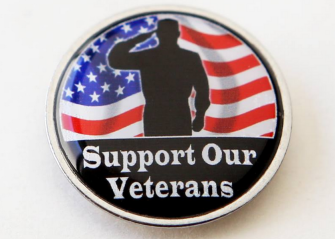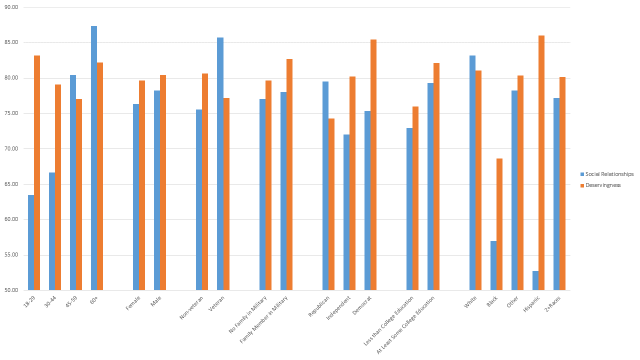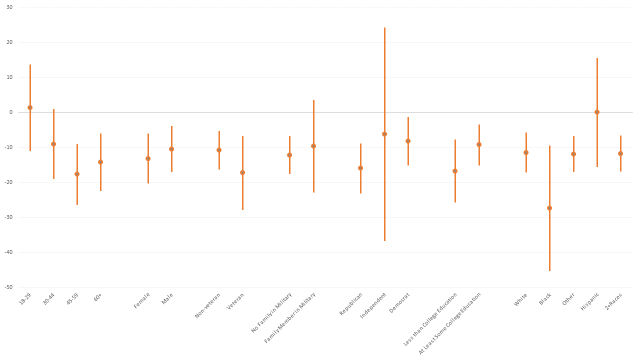In the nearly fifteen years since we began “creating” veterans of our wars in Afghanistan and Iraq, it would seem that the public has embraced contemporary veterans. The ritual of thanking those who serve or have served in the military at sporting events is one example. While veterans from the Vietnam War may have returned to a public they felt scorned and rejected them and their service, today’s veterans come home to a nation grateful for their sacrifices and eager to support them. And there are virtually no public voices openly critiquing or questioning veterans or their service.

In a past research project, a colleague and I investigated public attitudes toward a fictitious military veteran we described in a short vignette. This study revealed very positive public perceptions of veterans, especially those who had been exposed to combat. Although exposure to combat increased public perceptions of having problems with mental health, substance use, or violence, veterans, especially combat veterans, were seen as highly deserving of government assistance and of preferential treatment in hiring. And the public saw combat veterans as someone they would like to have as a neighbor, co-worker, and friend. Our empirical findings seemed consistent with the world we personally observed, one that was highly supportive of contemporary veterans. But we repeatedly heard from veterans who felt otherwise and saw some popular writings that that expressed concerns about the civil-military divide and its possible negative implications for veterans.

As researchers, we were concerned that our findings might be partly the result of what social scientists call “socially desirability bias” (SDB for short). SDB occurs when people hide their true feelings, instead responding to questions in ways that portray what is seen to be the social acceptable or desirable answer. Survey questions about race are often fraught with SDB because we “know” not to espouse racist views openly. Rather, socially undesirable views are often hidden, but still present in everyday life and interactions.
In a subsequent project we set out to try and investigate public opinions about contemporary veterans while also seeking to understand whether people somehow mask their true feelings about veterans for fear of appearing to NOT “support the troops.” The results of this project have recently been published in Armed Forces and Society.
Study methods
To investigate public attitudes toward veterans, we could easily ask a set of standard survey questions. But, to understand the extent to which such direct questions might lead to socially desirable responding—over or understating one’s true views to appear more consistent with the publicly acceptable views—we needed to turn to a technique called the item count technique, also called a list experiment. The technique is quite simple.
A sample is randomly split into treatment and control groups, offering respondents in each group a list of items. The control group is asked to report the number of items from a list of non-sensitive items or statements with which s/he agrees. The treatment group receives the same instruction, but with a list that includes an additional item hypothesized to elicit socially desirable responses. The difference in average count between treatment and control groups provides an unbiased estimate of the proportion of people who would agree with the sensitive item. Respondents can mask controversial views because they are only indirectly asked about that item. Careful choice of the non-sensitive items provides “cover” to respondents with views that they wish to hide.
For a concrete example, a researcher might assess racist attitudes by asking a control group the following:
“Now I’m going to read you three things that sometimes make people angry or upset. After I read all three, just tell me HOW MANY of them upset you. (I don’t want to know which ones, just how many).” Respondents would be given a list of three items: “the federal government increasing the tax on gasoline; professional athletes making multi-million dollar salaries; large corporations polluting the environment.” A treatment group would have the following item added to the items: “a black family moving in next door to you.” The difference in average item count between treatment and control groups provides an estimate of the “true” proportion of respondents who would be upset by a black family moving in next door. For example, if all respondents agreed with the three non-sensitive items, and assuming random assignment to groups, the average count for the control group would be 3, while in the treatment group it would be 3 plus the proportion who agreed with the sensitive time about race. If the estimated count for the treatment group was 3.75, results would estimate that 75% of respondents would be angered by a black family moving in next door. If a third group was asked to respond to each of the four items, including the sensitive one, individually, then you could compare the results from asking the question directly, to the estimate that doesn’t include SDB and see how much people lie about controversial attitudes.
Our study asked about two attitudes toward veterans—interest in engaging in social relationships with veterans, and their deservingness of government-subsidized healthcare. For the real enthusiasts, you can download our study data. We posed the following two questions:
Below is a list of different kinds of people who might move to a home near you. How many of these types of people would you be pleased to have move in next door to you? I don’t want to know which ones, just how many in total.
- A professional musician
- Someone convicted of driving under the influence of alcohol
- Someone who teaches kindergarten
How many of these would you be pleased to have move in next door to you?
The treatment group was given the same question, with this item added to the list (with the order of items randomized when fielded):
- A recent veteran of the wars in Iraq/Afghanistan.
And
Your taxes support numerous programs, including the ones listed below. How many of these programs should the government spend more to support? I don’t want to know which ones, just how many in total.
- Improvements in elementary school education
- Regular pay raises for members of Congress
- Repairing infrastructure such as roads and bridges
How many of these deserve increased support?
The treatment group was asked the same question, with this item added to the list (with item order randomized when fielded):
- Health care for veterans of the wars in Iraq/Afghanistan.
What we found
Figure 1 shows what “true” attitudes toward veterans on two different dimensions look like, broken down by several demographic subgroups. When it comes to wanting to engage in closer social relationships with veterans, older individuals, other veterans, and Whites show the highest levels of support for veterans. Younger people and those who are Black or Hispanic show the lowest levels of interest in close social relationships with veterans. But patterns differ slightly when it comes to views that veterans are deserving of more government spending on their healthcare. On this measure, young people, Democrats, Hispanics, and military family members show the highest levels of support, with Blacks, veterans, and Republicans showing the lowest levels of this kind of support for veterans.
Figure 1: Percent expressing supportive attitudes toward veterans on two different measures

These are the “true” views which have been purged of the effects of socially desirable reporting. But which groups tended to overstate their support for veterans the most? We would expect that the groups with the lowest “true” levels of support would be those most likely to overstate that support if there is a social imperative to show support for veterans. The two figures below show the estimates of the degree of bias in reporting on these questions. We compute this estimate of bias by taking the difference between the estimates in the earlier figure, and the results of asking people to respond directly to the question. Those groups with the dot (the point estimate) farthest below 0 are the groups that overstate their support the most. The lines show 95% confidence intervals, and allow one to assess the precision of our estimate. If the bars cross 0, we cannot statistically exclude 0 as a possible value for the extent of bias in reporting.
Figure 2: Extent of over-reporting support for engaging in social relationships with veterans

Figure 3: Extent of over-reporting of support for increased spending on veterans’ healthcare

Both figures confirm the suspicion that the groups with the lowest levels of true supportive attitudes are exactly the groups who overstate that support the most when asked directly. Black and Hispanic respondents, and young adults are most apt to lie about their interest to have close social relationships with contemporary veterans. But Blacks, veterans, and Republicans show the greatest levels of overstatement of their support for spending on veterans healthcare.
What to make of all this?
With only 1.5% of the adult population having served in these two wars, some military and veterans’ advocates have suggested that the public is disconnected from those who serve, which could lead to ambivalence toward veterans’ successful reintegration, if not hostility to providing the support and services they need. Our data reject the likelihood that there is latent hostility toward veterans and their care, showing instead that the context of reception for veterans returning from the recent wars appears very positive. Overall, levels of support are generally high and reflect what has been called a “sea of goodwill.” However, our results are somewhat concerning, suggesting that there is a non-trivial amount of socially desirable reporting about support for veterans, and that support varies across key demographic groups. African-Americans in particular appear to fairly consistently overstate their support for veterans by roughly 25 percentage points. This places them among those with the lowest overall levels of “true” support for veterans.
The results for African Americans are not only noteworthy, they are somewhat surprising. Researchers have suggested that members of racial minority groups benefit more from being veterans themselves than do others in terms of the post-military employment, education, and earnings. Blacks have also tended to serve in the military in greater numbers than their population share would suggest. Military service has been characterized as a unique source of opportunity for upward mobility for African Americans. Despite higher rates of service, and greater returns on that experience, African Americans express the lowest levels of support for veterans, and the most biased reporting about that support. Our data do not offer any clear insights into why this may be the case.
It is possible that people do not distinguish the war from the warrior. African Americans express less support for military conflicts than whites, with some of the largest racial gaps in support of (or opposition to) military conflicts evidenced for the Iraq conflict. If African Americans are unsupportive of the wars in Iraq and Afghanistan they may be less supportive of veterans of those wars as well. We cannot know what kind of veteran our respondents envision when prompted, but it may be a stereotypical white man from the South, or rural origins. Should African Americans envision this particular kind of veteran, they may unconsciously react to the envisioned characteristics other than veteran status alone. The very low levels of support on the social distance measure would be consistent with such a speculation, but further research is needed to understand why some groups responded as they did.
We also found it notable that Republicans showed higher levels of socially desirable responding such that they show roughly the same true levels of support for social engagement with veterans as Democrats, and substantially lower levels of support for public spending on veteran healthcare. With military-connected populations seen as a Republican-leaning group, the fact that Republicans express the same or less supportive attitudes as Democrats toward veterans may have implications for the future of veteran policy. There are no organized interest groups seeking to (explicitly) reduce veterans’ benefits, but discussions over the VA Choice program, and the possible privatization of veteran’s healthcare do fall along partisan lines. Our results imply the discussion about how to support veterans in policy efforts may be more about whether to do so through public or private solutions, rather than to provide more or less funding. But our results also challenge notions that Democrats are somehow anti-military or anti-veteran.
Attitudes toward veterans are consistently high across a range of demographic subgroups. However, given these findings of substantial overstatement of support from some groups, concerns about a civil-military divide may be partially warranted. We may say we support the troops and veterans, while not actually supporting policies and programs benefiting them.
